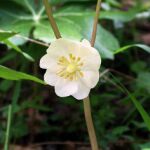
The mayapple, native to the woodlands of Canada and the eastern United States, is a small plant that produces a single white flower in may which, later turns into a yellow berry that resembles a tiny apple. The mayapple rhizome contains high amounts of the compounds pogophyllotoxin and alpha and beta peltatin, which have cancer-fighting properties. Extracts of mayapple are currently used in certain topical medications for genital warts and some forms of skin cancer.
Perennial with a red-brown rhizome, to 2m (6ft) long, and upright stems, bearing drooping, 5-9-lobed, toothed leaves, to 30cm (12in) long. Solitary, semi-pendent, bowl-shaped white flowers 5cm (2in) across, are followed by yellow fruits, to 5cm (2in) long.
To treat warts, fever, snakebite, and syphillis; and as a laxative. Germany’s Commission E has approved the use of mayapple to treat warts. |
|||||||||||||||||||||||||||||||||||
|
|
|||||||||||||||||||||||||||||||||||
|
|||||||||||||||||||||||||||||||||||
Contraindicated during pregnancy This herb is subject to legal restrictions in most countries.</B< |
|||||||||||||||||||||||||||||||||||
The Essential Herb-Drug-Vitamin Interaction Guide by Geo. T. Grossberg,MD and Barry Fox,PhD Copyright©2007 Barry Fox,PhD. Pp. 337-338 |
|||||||||||||||||||||||||||||||||||


